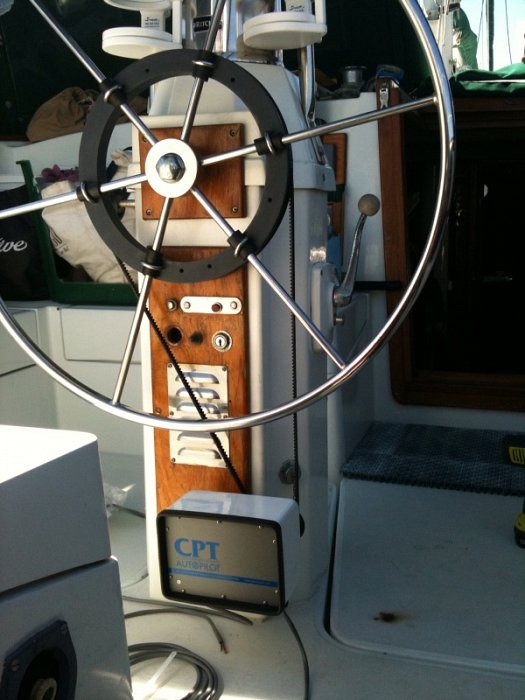motion30
Guru
- Joined
- Jan 14, 2010
- Messages
- 1,181
I have a twin engine 44 ft 40,000 lb Sun deck Cruiser. It has a single Helm on the flybridge I am looking for recommendation for an autopilot
Problem with recommendations is everyone will recommend what they have to affirm their selection.
I'm not going to recommend what I have as it's long out of production. That said, I like my Simrad / Robertson AP20 so much thst I've resisted upgrading it even though it's 17 years old.
Probably can't go wrong with a Garmin, Comnav, or Simrad.
Ted
I have been researching APs. If you have hydraulic steering, you have two choices. Hydraulic of course and they can be expensive, or mechanical. The mechanical unit uses a motor to drive a pulley that is attached to the wheel. Once that is solved, you can figure out if you want to tie into the electronics for full operation or have a stand-alone system that runs a heading you set until you switch it off or set a new heading.I am only familiar with the tiller style autopilot. I imagine I need something with a hydraulic pump. Googling I only see kits that are not complete. So I'm asking being unfamiliar with autopilot components what all I need to make a functioning system does anybody offer an all-in-one component kit that has everything in one box?


Agreed, have a jog lever for my stern docking station. Also see what is offered for remotes. Personally I prefer hardwired. Seems that remotes and jog levers are an area where most manufacturers are offering less choices and technology really hasn't improved. Part of what keeps me from upgrading is less choice in these items compared to what I currently have.Be sure you get one that supports a JOG stick.
A lot of people use that exclusively, and never go back to a wheel.
If you already have a radar unit or chartplotter from one manufacturer then integrating an autopilot from that same manufacturer will probably be simpler. Having a certified local tech to debug inoperative systems has a lot more value than manufacturers claimed "feature" list.

Problem with recommendations is everyone will recommend what they have to affirm their selection...
Buy the one the commercial guys buy. Mostly Comnav...
FWIW Si-tex = Comnav or the other way around(can't remember) but Sitex stuff is good to go.
I use a Garmin Tr1(few generations old) that I bought parts used for around $500 so in that respect I recommend it.
I'd prefer a simple electric wheelpilot. Dialing the TR1 in isn't awesome and it has enough extras to make it kind of a pain.
"Delivers 86ft-lbs to the wheel." I believe that should cover it.I like the Simplicity of the electric Wheel pilot. who makes one I can handle a 44000lb. 44ft boat?
I like the Simplicity of the electric Wheel pilot. who makes one I can handle a 44000lb. 44ft boat?
the insulation doesn't deal with hydraulic hoses and bleeding the system
A good explanation by Kevin. I have a Comnav AP that is linked to my Furuno chartplotter. Contrary to Kevin's ocean application, I use my pilot to steer to chartplotter waypoints to take advantage of the cross-track error adjustment. This is particularly useful in legs of over, say, 10 miles with current or wind affecting the track of the boat.
